Class 11 - Physics
Chapter 15 - Waves
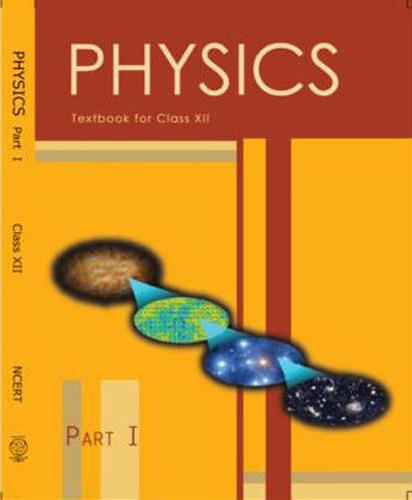
Top Block 1
Question :1 :
A string of mass 2.50 kg is under a tension of 200 N. The length of the stretched string is 20.0 m.
If the transverse jerk is struck at one end of the string, how long does the disturbance take to reach the other end?
Answer :
Mass of the string, M = 2.50 kg
Tension in the string, T = 200 N
Length of the string, l = 20.0 m
Mass per unit length, μ= (M/l)
= (2.50/20)=0.125kgm-1
The velocity (v) of the transverse wave in the string is given by the relation:
v= (√T/ μ)
= (√200/0.125)
=√1600=40m/s
Therefore, time taken by the disturbance to reach the other end,
t = (l/v)
= (20/40) =0.50s
Question : 2.
A stone dropped from the top of a tower of height 300 m high splashes into the water of a pond near the base of the tower.
When is the splash heard at the top given that the speed of sound in air is 340 m s–1? (g = 9.8 m s–2)
Answer :
Given:
Height of the tower, s = 300 m
Initial velocity of the stone, u = 0
Acceleration, a = g = 9.8 m/s2
Speed of sound in air = 340 m/s
The time (t1) taken by the stone to strike the water in the pond can be calculated using the second equation of motion, as:
s = ut1 + (1/2) gt12
300 = (0 + (1/2) x 9.8 x t12)
Therefore, t1 = √ (300 x 2)/ (9.8)
Time taken by the sound to reach the top of the tower,
t2 = (300/340) =0.88s
Therefore, the time after which the splash is heard,
t= (t1 + t2)
= 7.82 + 0.88 = 8.7 s
Question : 3.
A steel wire has a length of 12.0 m and a mass of 2.10 kg.
What should be the tension in the wire so that speed of a transverse wave on the wire equals the speed of sound in dry air at 20 °C = 343 m s–1?
Answer :
Length of the steel wire, l = 12 m
Mass of the steel wire, m = 2.10 kg
Velocity of the transverse wave, v = 343 m/s
Mass per unit length, μ= (m/l) = (2.10/12) =0.175kgm-1
For tension T, velocity of the transverse wave can be obtained using the relation:
v= (√T/ μ)
Therefore T= (v2 μ)
= ((343)2 × 0.175)
= 20588.575 ≈ 2.06 × 104 N
Question : 4.
Use the formula v = (√ (γ P)/ρ) to explain why the speed of sound in air
(a) is independent of pressure,
(b) increases with temperature,
(c) increases with humidity.
Answer :
Given:
v = (√ (γ P)/ρ) … (i)
Where Density ρ = (Mass)/ (volume)
= (M/V) where M = Molecular weight of thee gas and V = volume of the gas.
Therefore equation (i) changes to,
v = (√ (γ PV)/ (M) … (ii)
Considering the ideal gas equation for n = 1:
PV = RT
For constant T, PV = Constant
Since both M and γ are constants, v = Constant
Hence, at a constant temperature, the speed of sound in a gaseous medium is independent of the change in the pressure of the gas.
Using:
v = (√ (γ P)/ρ) … (i)
For one mole of an ideal gas, the gas equation can be written as:
PV = RT
Or P = (RT)/ (V) … (ii)
Substituting equation (ii) in equation (i), we get:
v = (√γ RT/V ρ)
= (√γRT/M) … (iv)
Where,
Mass, M = ρV is a constant, (γ and R) are also constants
We conclude from equation (iv) v √T
Hence, the speed of sound in a gas is directly proportional to the square root of the temperature of the gaseous medium, i.e.,
the speed of the sound increases with an increase in the temperature of the gaseous medium and vice versa.
Speed of sound in moist air = vm
Speed of sound in dry air = vd
Density of moist air = ρm
Density of dry air = ρd
Using:
v = (√ (γ P)/ρ)
Hence, the speed of sound in moist air is:
vm = (√ (γ P)/ρm) …(i)
And the speed of sound in dry air is:
vd = (√ (γ P)/ρd) …(ii)
On dividing equations (i) and (ii), we get:
(vm/ vd) = ((√γ P)/ ρm) x (√ (ρd)/ (γ P)
= √ (ρd)/ (ρm)
However, the presence of water vapour reduces the density of air, i.e.
(ρd) < (ρm)
Therefore, (vm) > (vd)
Hence, the speed of sound in moist air is greater than it is in dry air. Thus, in a gaseous medium, the speed of sound increases with humidity.
Question : 5.
You have learnt that a travelling wave in one dimension is represented by a function y = f (x, t) where x and
t must appear in the combination x – v t or x + v t, i.e. y = f (x ± v t).
Is the converse true? Examine if the following functions for y can possibly represent a travelling wave:
(a) (x – vt) 2
(b) log [(x + vt)/x0]
(c) 1/(x + vt)
Answer :
The converse is not true. Because the essential requirement for a function to represent a travelling wave is that it should remain finite for all values of x and t.
- It does not represent a wave.
For x = 0 and t = 0, the function (x – vt) 2 becomes 0.
Hence, for x = 0 and t = 0, the function represents a point and not a wave.
- It represents a wave. For x = 0 and t = 0, the function
log ( (x + vt)/(x0)
=log 0 = ∞
Since the function does not have a finite value for x = 0 and t = 0, therefore it represents a travelling wave.
- It does not represent a wave .For x = 0 and t = 0, the function
(1/(x + vt)) = (1/0) =∞
Since the function does not converge to a finite value for x = 0 and t = 0, it does not represent a travelling wave.
Question : 6.
A bat emits ultrasonic sound of frequency 1000 kHz in air. If the sound meets a water surface, what is the wavelength of
(a) the reflected sound, (b) the transmitted sound? Speed of sound in air is 340 m s –1 and in water 1486 m s–1.
Answer :
Frequency of the ultrasonic sound, ν = 1000 kHz = 106 Hz
Speed of sound in air, va = 340 m/s
The wavelength (λr) of the reflected sound is given by the relation:
λr = (va/ ν) = (340/106) =3.4×10-4 m
Frequency of the ultrasonic sound, ν = 1000 kHz = 106 Hz
Speed of sound in water, vw = 1486 m/s
The wavelength of the transmitted sound is given as:
λr = (1486/106) =1.49 × 10–3 m
Question : 7.
A hospital uses an ultrasonic scanner to locate tumours in a tissue. What is the wavelength of sound in the tissue in which the speed of sound is 1.7 km s–1?
The operating frequency of the scanner is 4.2 MHz
Answer :
Speed of sound in the tissue, v = 1.7 km/s = 1.7 × 103 m/s.
Operating frequency of the scanner, ν = 4.2 MHz = 4.2 × 106 Hz.
The wavelength of sound in the tissue is given as:
λ= (ν/v)
= (1.7×103)/ (4.2×106)
= (4.1×10–4)
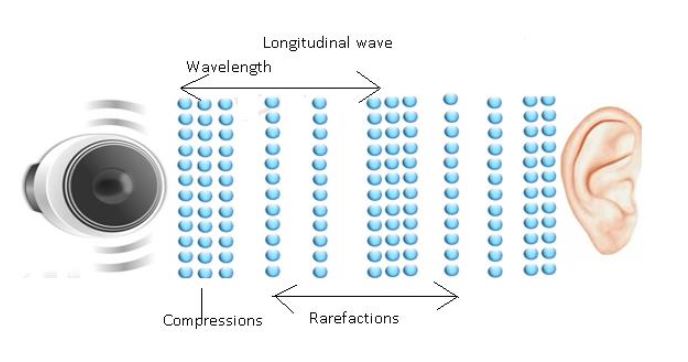
Question : 8.
A transverse harmonic wave on a string is described by
y(x, t) = 3.0 sin (36 t + 0.018 x + π/4)
Where x and y are in cm and t in s. The positive direction of x is from left to right.
(a) Is this a travelling wave or a stationary wave?
If it is travelling, what are the speed and direction of its propagation?
(b) What are its amplitude and frequency?
(c) What is the initial phase at the origin?
(d) What is the least distance between two successive crests in the wave?
Answer :
- Yes; Speed = 20 m/s, Direction = Right to left
- 3 cm; 5.73 Hz,
- (π/4)
- 49 m
Explanation:
The equation of a progressive wave travelling from right to left is given by the displacement
Function: y (x, t) = a sin (ωt + kx + Φ) … (i).
The given equation is:
y(x, t) =3.0sin (36t+0.081x+ (π/4))…(ii)
On comparing both the equations, we find that equation (ii) represents a travelling wave, propagating from right to left.
Now, using equations (i) and (ii), we can write:
ω = 36 rad/s and k = 0.018 m–1. We know that:
ν= (ω / (2 π)) and λ= (2 π)/ (k)
Also, v = νλ
Therefore, ν= (ω/ (2 π)) x (2 π/k) = (ω/k)
= (36)/ (0.018)=2000cm/s=20m/s
Hence, the speed of the given travelling wave is 20 m/s.
Amplitude of the given wave, a = 3 cm
Frequency of the given wave:
ν= (ω)/ (2 π) = (36)/ (2×3.14) =5.73Hz
On comparing equations (i) and (ii), we find that the initial phase angle,
Φ= (π/4)
The distance between two successive crests or troughs is equal to the wavelength of the wave.
Wavelength is given by the relation:
k= ((2π)/ λ)
Therefore,
λ= ((2π)/k) = (2×3.14)/ (0.018) = 348.89cm=3.49m
Question : 9.
For the wave described in Exercise 15.8, plot the displacement (y) versus (t) graphs for x = 0, 2 and 4 cm.
What are the shapes of these graphs? In which aspects does the oscillatory motion in travelling
wave differ from one point to another: amplitude, frequency or phase?
Answer :
The given transverse harmonic wave is:
y(x, t) =3.0sin (36t+0.081x+ (π/4)) …(i)
For x =0, the equation (i) becomes,
y(0, t) =3.0sin (36t + (π/4))
Also ω = (2 π)/ (T)
ω = 36rads-1
Therefore T = (π/8)
By plotting (y vs t) graph using the different values of t. The displacement (y) at different times can be tabulated as:

Mddle block 1
This is because amplitude and frequency are invariant for any change in x. The y-t plots of the three waves are shown in the given figure.
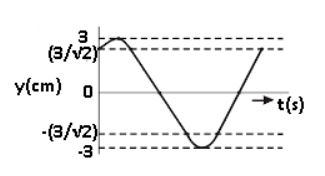
Question : 10.
For the travelling harmonic wave
y(x, t) = 2.0 cos 2π (10t – 0.0080 x + 0.35)
Where x and y are in cm and t in s. Calculate the phase difference between oscillatory motion of two points separated by a distance of
(a) 4 m,
(b) 0.5 m,
(c) λ/2,
(d) 3λ/4
Answer :
Equation for a travelling harmonic wave is given as:
y (x, t) = 2.0 cos 2π (10t – 0.0080x + 0.35)
= 2.0 cos (20πt – 0.016πx + 0.70 π)
Where,
Propagation constant, k = 0.0160 π
Amplitude, a = 2 cm
Angular frequency, ω= 20 π rad/s
Phase difference is given by the relation:
Φ = (kx) = (2 π)/ (λ)
For x = 4 m = 400 cm
Φ = 0.016 π × 400 = 6.4 π rad
For 0.5 m = 50 cm
Φ = 0.016 π × 50 = 0.8 π rad
For x = (λ/2)
Φ = (2 π/ λ) x (λ/2)
= π rad
For x= (3 λ/4)
Φ = (2 π/ λ) x (3 λ/4)
Φ = 1.5 π rad
Question : 11.
The transverse displacement of a string (clamped at its both ends) is given by
y(x, t) = 0.06 sin(2 π /3) x cos (120 πt)
Where x and y are in m and t in s. The length of the string is 1.5 m and its mass is (3.0 ×10–2) kg.
Answer the following:
(a) Does the function represent a travelling wave or a stationary wave?
(b) Interpret the wave as a superposition of two waves travelling in opposite directions. What are the wavelength, frequency, and speed of each wave?
(c) Determine the tension in the string.
Answer :
The given equation is:
y(x, t) = 0.06 sin(2 π /3) x cos (120 πt) ..(1)
- As the equation involves harmonic functions x and t separately, it represents a stationary wave.
- Equation of a wave when it is a pulse:
y1 = r sin (2 π/ λ) (vt –x) which is travelling along (+) ive x-axis and is superimposed by the reflected wave.
Also y2 = – r sin (2 π/ λ) (vt –x) a stationary wave travelling in opposite direction.
y = y1 + y2
=-2r sin (2 π/ λ) cos (2 π/ λ) (vt) is formed … (2)
By comparing equations (1) and (2),
(2 π/ λ) = (2 π /3)
=> λ = 3m
Also, (2 π/ λ) (v) = 120 π
Or v = 60 λ
=60 x 3
=180ms-1
Frequency ν = (v/ λ) = (180/3)
= 60Hz
Both the waves have same speed, same frequency and same wavelength.
- Velocity of transverse wave:
v = √ (T/m)
Or v2 = (T/m)
T = mv2 where m = (3 x 10-2)/ (1.5)
Therefore T = (180)2 x 2 x 10-2
=648N
Question : 12.
(i) For the wave on a string described in Exercise 15.11, do all the points on the string oscillate with the same (a) frequency, (b) phase, (c) amplitude?
Explain your answers. (ii) What is the amplitude of a point 0.375 m away from one end?
Answer :
- All the points on the string
- Have the same frequency of oscillation except at the nodes where frequency is 0.
- Have the same phase in one loop except at nodes.
- Have different amplitudes at different points.
(ii) The given equation y(x, t) = 0.06 sin ((2 π /3) x) cos (120 πt)
For x = 0.375m and t=0,
Amplitude = Displacement = 0.06 sin ((2 π /3) x) cos 0
= 0.06 sin ((2 π/3) x 0.375) x 1
= 0.06 sin (0.25 π) = 0.06 sin (π/4)
=0.06 x (1/√2)
=0.042m
Question : 13.
Given below are some functions of x and t to represent the displacement (transverse or longitudinal) of an elastic wave.
State which of these represent (i) a travelling wave, (ii) a stationary wave or (iii) none at all:
(a) y = 2 cos (3x) sin (10t)
(b) y = 2√ (x – vt)
(c) y = 3 sin (5x – 0.5t) + 4 cos (5x – 0.5t)
(d) y = cos x sin t + cos 2x sin 2t
Answer :
- As the equation contains harmonic functions x and t separately, therefore it represents stationary wave.
- It does not represent any type of wave.
- It represents harmonic wave.
- The given equation is sum of two functions, representing a stationary wave. It actually represents the superposition of two stationary waves.
Question :14.
A wire stretched between two rigid supports vibrates in its fundamental mode with a frequency of 45 Hz.
The mass of the wire is 3.5 × 10–2 kg and its linear mass density is 4.0 × 10–2 kg m–1.
What is (a) the speed of a transverse wave on the string, and (b) the tension in the string?
Answer :
Length of wire L = (Mass of wire)/ (Linear density)
= (3.5 × 10–2)/ (4.0 × 10–2)
= 0.875m
- When the wire vibrates in its fundamental mode, then,
L = (λ/2)
Or λ = (2L)
= 2 x 0.875
=1.75m
Therefore speed of transverse waves v =f λ
=45 x 1.75
=78.75ms-1
- Also v =√(T/m)
Or T = v2 m
Therefore T = (78.75)2 x (4.0 × 10–2)
=248.1N
Question : 15.
A metre-long tube open at one end, with a movable piston at the other end, shows resonance with a fixed frequency source (a tuning fork of frequency 340 Hz)
when the tube length is 25.5 cm or 79.3 cm. Estimate the speed of sound in air at the temperature of the experiment.
The edge effects may be neglected.
Answer :
Frequency of the turning fork, ν = 340 Hz
Since the given pipe is attached with a piston at one end, it will behave as a pipe with one end closed and the other end open, as shown in the given figure.
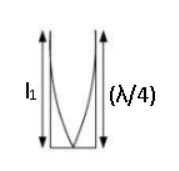
l1 = (λ/4) Where,
Length of the pipe, l1 = 25.5cm = 0.255m
Therefore, λ = (4 l1) = 4 x 0.255 = 1.02m
The speed of sound is given by the relation:
v = (ν λ)
= 340 × 1.02 = 346.8 m/s
Question : 16.
A steel rod 100 cm long is clamped at its middle. The fundamental frequency of longitudinal vibrations of the rod is given to be 2.53 kHz.
What is the speed of sound in steel?
Answer :
Length of the steel rod, l = 100 cm = 1 m
Fundamental frequency of vibration, ν = 2.53 kHz = 2.53 × 103 Hz
When the rod is plucked at its middle, an antinode (A) is formed at its centre, and nodes (N) are formed at its two ends, as shown in the given figure.
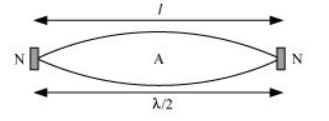
Therefore, l= (λ/2)
λ = (2l) =2×1=2m.
The speed of sound in steel is given by the relation:
v = νλ
= (2.53 × 103 × 2)
= 5.06 × 103 m/s
= 5.06 km/s
(Pic taken from ncert and modified in ms-paint)
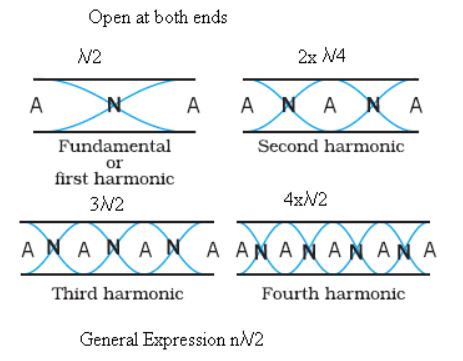
Question : 17.
A pipe 20 cm long is closed at one end. Which harmonic mode of the pipe is resonantly excited by a 430 Hz source?
Will the same source be in resonance with the pipe if both ends are open? (Speed of sound in air is 340 m s–1).
Answer :
The frequency of nth mode of vibration of a pipe closed at one end is given by
νn = (2n- 1)(ν/4L)
ν=340ms-1; L=20cm=0.2m; νn=430Hz.
Therefore 430= ((2n-1) x 340)/ (4×0.2)
=>n=1
Therefore, first mode of vibration of the pipe is excited, for open pipe since n must be an integer,
the same source cannot be in resonance with the pipe with both ends open.
Stationary waves in a stretched string fixed at both ends. Various modes of vibration are shown.

Question : 18.
Two sitar strings A and B playing the note ‘Ga’ are slightly out of tune and produce beats of frequency 6 Hz.
The tension in the string A is slightly reduced and the beat frequency is found to reduce to 3 Hz.
If the original frequency of A is 324 Hz, what is the frequency of B?
Answer :
Given:
Frequency of string A, fA = 324Hz
Frequency of string B = fB
Frequency of beats, n = 6Hz
Frequency of beats = n | fA ± fB|
6 = 324 ± fB
fB = 330Hz or 318Hz
Frequency decreases with a decrease in the tension in a string. Because frequency is directly proportional to the square root of tension
ν ∝√T
Therefore the beat frequency cannot be 330Hz.
Therefore, fB = 318Hz
Question : 19.
Explain why (or how):
(a) in a sound wave, a displacement node is a pressure antinode and vice versa,
(b) bats can ascertain distances, directions, nature, and sizes of the obstacles
without any “eyes”,
(c) a violin note and sitar note may have the same frequency, yet we can distinguish between the two notes,
(d) solids can support both longitudinal and transverse waves, but only longitudinal waves can propagate in gases, and
(e) the shape of a pulse gets distorted during propagation in a dispersive medium.
Answer :
- A node is a point where the amplitude of vibration is the minimum and pressure is the maximum. On the other hand,
- an antinode is a point where the amplitude of vibration is the maximum and pressure is the minimum.
Therefore, a displacement node is nothing but a pressure antinode, and vice versa.
- Bats emit very high-frequency ultrasonic sound waves. These waves get reflected back toward them by obstacles.
- A bat receives a reflected wave (frequency) and estimates the distance, direction, nature, and size of an obstacle with the help of its brain senses.
- The overtones produced by a sitar and a violin, and the strengths of these overtones, are different.
- Hence, one can distinguish between the notes produced by a sitar and a violin even if they have the same frequency of vibration.
- Solids have shear modulus. They can sustain shearing stress. Since fluids do not have any definite shape, they yield to shearing stress.
- The propagation of a transverse wave is such that it produces shearing stress in a medium. The propagation of such a wave is possible only in solids, and not in gases.
- Both solids and fluids have their respective bulk moduli. They can sustain compressive stress. Hence, longitudinal waves can propagate through solids and fluids.
A pulse is actually is a combination of waves having different wavelengths.
These waves travel in a dispersive medium with different velocities, depending on the nature of the medium. This results in the distortion of the shape of a wave pulse.
Question : 20.
A train, standing at the outer signal of a railway station blows a whistle of frequency 400 Hz in still air.
(i) What is the frequency of the whistle for a platform observer when the train
(a) Approaches the platform with a speed of 10 m s–1, (b) recedes from the platform with a speed of 10 m s–1?
(ii) What is the speed of sound in each case? The speed of sound in still air can be taken as 340 m s–1.
Answer :
Given:
- Speed of sound in air , v = 340ms-1
Frequency of the whistle, ν= 400Hz
Speed of train v1 = 10m/s
The apparent frequency (ν’) of the whistle as the train approaches the station is given as:
ν’ = (v)/ (v- v1))( ν)
= ((340)/ (340 -10)) x 400
= 412.12 Hz
- The apparent frequency (ν’’) of the whistle as the train recedes from the platform is given as:
ν” = (v)/ (v+ v1))( ν)
= ((340)/ (340+10)) 400
= 388.57Hz
Question : 21.
A train, standing in a station-yard, blows a whistle of frequency 400 Hz in still air.
The wind starts blowing in the direction from the yard to the station with at a speed of 10 m s–1.
What are the frequency, wavelength, and speed of sound for an observer standing on the station’s platform?
Is the situation exactly identical to the case when the air is still and the observer runs towards the yard at a speed of 10 m s–1?
The speed of sound in still air can be taken as 340 m s–1
Answer :
Given:
Frequency of whistle ν = 400 Hz
Speed of wind vw = 10m/s
Speed of sound in still air = 340 m/s
In case of stationary observer:-
There is no relative motion between the source and the observer, therefore the frequency of the sound heard
will be the same as that produced by the source i.e. 400Hz.
This implies the wind is blowing towards the observer.
Therefore, the effective speed of the sound increases by 10 units, i.e.
Effective speed of the sound, ve = (340 + 10) = 350 m/s
The wavelength (λ) of the sound heard by the observer is given by the relation:
λ = (ve)/ (vw)
In case of running observer:-
Velocity of the observer, vo = 10 m/s
As the observer is moving toward the source, therefore there is a relative motion between the source and the observer,
which results in change in the frequency (v’).
This is given as:
v’ = ((vw + vo)/(vw)) v
= ((340 + 10)/ (340)) 400
=411.76Hz
As air is not blowing i.e. it is still, therefore the effective speed of sound
= 340 + 0 = 340 m/s
The source is at rest. Hence, the wavelength of the sound will not change i.e.
λ will be 0.875 m.
The given two situations are not exactly identical.
Bottom Block 3
Click here to visit Official CBSE website
Click here for NCERT solutions
Click here to visit Official Website of NCERT
Click here to download NCERT Textbooks
